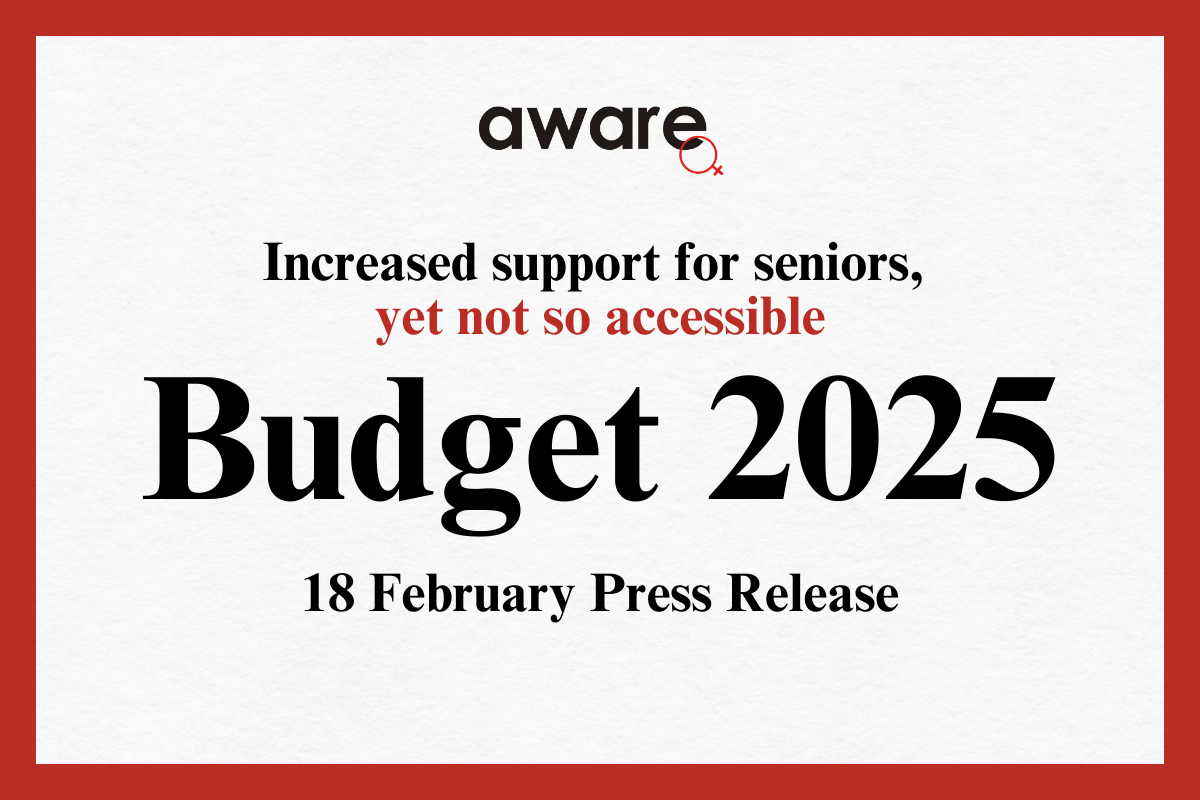-
Advocacy Theme
-
Tags
- Abortion
- Adoption
- Caregiving
- CEDAW
- Disability
- Domestic Violence
- Domestic Workers
- Harassment
- Healthcare
- Housing
- International/Regional Work
- Maintenance
- Media
- Migrant Spouses
- Migrant Workers
- Muslim Law
- National budget
- Parental Leave
- Parenthood
- Polygamy
- Population
- Race and religion
- Sexual Violence
- Sexuality Education
- Single Parents
- Social Support
- Sterilisation
- Women's Charter
AWARE’s response to Budget Statement 2025
February 18th, 2025 | Children and Young People, Family and Divorce, News, Older People and Caregiving
An extract of this article was sent to the press on 18 Feb 2025.
The Budget 2025 statement on 18 February promised some important measures to support seniors and caregivers. The new Matched MediSave Scheme is a welcome step, helping low-income seniors build healthcare savings—but many may struggle to set aside the cash to benefit from it.
“We also welcome enhancements to ComCare and caregiving grants, but caregiving remains a major financial strain, especially for women.” said Sugidha Nithiananthan, the Director of Advocacy and Research at AWARE.
“More sustained support is needed to ensure that unpaid caregiving and low-wage work don’t leave families struggling. We hope to see further steps towards a more secure, inclusive future for all.”
Increased Support for Seniors, Yet Not So Accessible
This year’s Budget introduces key improvements for Singapore’s ageing population, set to take effect in July 2026 with interim enhancements from July 2025.
Support for Lower-Income Seniors’ Healthcare Savings:
- Lower-income seniors aged 55 to 70 can get a boost to their MediSave.
- For every dollar they contribute, the government will add another dollar.
- This matching is capped at $1,000 per year.
- The scheme will run for five years.
- To qualify, seniors need to meet certain criteria, including an income limit of $4,000 or less per month and limited property ownership. Their MediSave balance also needs to be below a certain level.
Increased Long-Term Care Subsidies:
- The government is increasing subsidies to help with the costs of long-term care for frail and ill seniors.
- For Singaporeans born in 1969 or earlier:
- Subsidies for staying in residential long-term care facilities will go up by as much as 20%.
- Subsidies for receiving care at home or in the community will increase by up to 25%.
- For Singaporeans born after 1969:
- Subsidies for residential long-term care will increase by up to 15%.
- Subsidies for home and community care will increase by up to 10%.
After these increases, eligible Singaporeans can receive:
- For those born in 1969 or earlier:
- Subsidies of 15% – 80% for residential long-term care facilities.
- Subsidies of 35% – 95% for home and community care.
- For those born after 1969:
- Subsidies of 10% – 75% for residential long-term care facilities.
- Subsidies of 20% – 80% for home and community care.
This new MediSave matching scheme works alongside the existing Matched Retirement Savings Scheme, which helps people build their retirement funds. This scheme now has a higher matching cap and is open to those aged 55 and older.
AWARE has long advocated for better support for seniors and their caregivers and is pleased to see these developments. However, low-income families may struggle to set aside the cash to fully benefit from the Matched MediSave Scheme.
Promising Increase to ComCare
Enhancing ComCare is a step in the right direction; AWARE has consistently called for improvements to ComCare—including higher payouts and longer durations of assistance—to provide more stable relief to low-income households.
Changes to the ComCare Long-term Assistance Rates:
| Household Size | Current Rates | Increased Rates (From April 2025) |
| 1 person | $640 | $760 |
| 2 persons | $1,080 | $1,250 |
| 3 persons | $1,510 | $1,760 |
| 4 persons | $1,930 | $2,230 |
The increases will need to not only outpace inflation but also ensure that all households meet living wage standards.
Marginal Subsidies to Cost of Raising Children
The lowered preschool fee caps—to $640 a month for anchor operators and $680 for partner operators—and the new Large Families Scheme—which gives parents $5,000 for each third and subsequent Singaporean child—will help make having children more accessible and affordable. We hope that the much higher cost of living can be more adequately addressed, as it remains a barrier for low-income families.
We also hope that subsidies designed to help parents will include the non-citizen children of Singaporeans in the future. Excluding non-citizen children has a long-term impact on the Singaporean families to which they belong because the higher non-citizen school fees they have to pay impacts the overall cost to the family. For example, our research shows that parents of a primary-school Singaporean child pays $13 a month for public schooling, whereas a permanent resident child would be charged $293. Parents of foreign students are at a further disadvantage; those going to primary school would pay $559 (ASEAN) and $949 (non-ASEAN) monthly.
Small Enhancement to Caregiver Support
Caregiving remains a full-time commitment for many, especially women. The $200 increase in the Home Caregiving Grant (from $400 to $600), and the greater accessibility with the increase in maximum qualifying per capita household income to $4,800, are welcome steps in recognising caregivers’ financial strain.
However, these measures don’t meaningfully address the loss of income experienced when caregiving responsibilities compete with paid work. We urge further investment in sustained income support and re-employment pathways to ensure caregiving does not come at the expense of financial security.
This could come in the form of the government paying caregivers a universal basic income, or a more robust Caregiver Support Grant with cash and CPF components.
Singapore also needs to collect disaggregated data based on gender, age, ethnicity, and nationality, amid other characteristics, and develop policies that fully address our caregivers’ needs.




